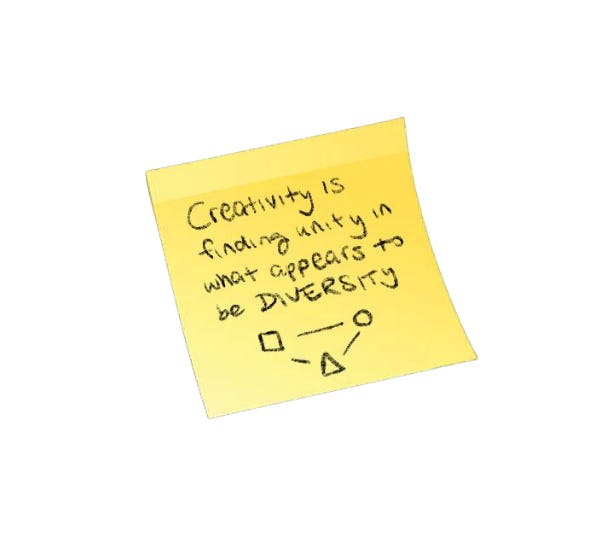Neuro Post-it 3: The neuroscience behind visual creativity
A new series of neuroscientific digestible insights! Written in collaboration with Amirali Banani.
From ancient cave paintings to contemporary digital art, humans have always been drawn to visuals.
What is the creativity and neuroscience behind this universal human impulse? How does it work, and why is it so deeply ingrained in our history?
Hardwired for visuals
As humans, we have a tendency of preferring images over words, a phenomenon called Picture Superiority Effect. This has been explained by Paivio’s Dual Code Theory, which suggests that pictures are encoded both visually and verbally, leading to a redundancy that makes pictures easier to recall.
This means that brains are naturally optimized for visual thinking, because, unlike sounds, which must be interpreted sequentially and abstractly, images provide a more direct and redundant form of encoding (and redundancy works so well with neuroplasticity).
Evolution
Visual creativity has deep evolutionary roots, as one may easily imagine. Early humans used visuals as vital survival tools and communication language; in fact cave art often depicted hunting scenes and served as pinpoints, encoding information about the environment that could have been used by the entire group. This fostered cohesion and knowledge transmission that ultimately led to the group’s collective survival.
Over time, art evolved from early art mimicking nature or daily life, to more abstract representations.
The neuroscience behind visual creativity
Creativity is finding unity in what appears to be diversity - Brownoski, 1972
Creativity can be defined as the development of new or novel understanding that leads to the expression of orderly and systematic relationships or new relationships between pre-existent understandings.
Helmholtz (1826) and Wallas (1926) proposed
preparation: acquisition of background knowledge and learning skills to develop creative ideas
incubation: unconscious reasoning about how they can develop a creative product
illumination: sudden realisation/awareness of the creative solution, the famous “Ah-ha!” experience
verification and production: as do scientists, also artists test and refine their hypothesis (or creative ideas) through systematic observation or experimentation
But what are the actual portions of our brain interested in these processes?
visual cortex, located in the occipital lobe: processes visual information such as color, shape, and spatial relationships
prefrontal cortex: mostly involved in abstract thinking, planning, and decision-making (where most of the “ah-ha!” moment arises)
premotor cortex and supplementary motor cortex: governs the motor control necessary for artistic creation as well as the “thinking about creating”
Other areas involved, but that needs more research and further development, are the right middle frontal gyrus and inferior frontal gyrus.
The creative spark
As previously described, creativity comes from the dynamic interconnection between different mechanisms: perception, cognition, expression and subconscious/unconscious reasoning.
Resources
doi: 10.1016/B978-0-444-63287-6.00002-6.
https://www.researchgate.net/publication/233603316_Art_and_the_Brain
https://www.cmu.edu/dietrich/psychology/memorylab/publications/10.1.1.646.3474.pdf
https://royalsocietypublishing.org/doi/10.1098/rstb.2014.0099?
Bronowski, J., 1972. Science and Human Values. Harper and Row, New York.
Co-written with the brilliant
.






Would love a deep dive on the nuances on languages e.g Chinese written language and characters are visual based vs english alphabet. And whether visual attributes in written language 'promotes' creativity more in some more than others in other languages
This was great. I’m a stem geek with a passion for the arts. The connection between the 2 is so fascinating.